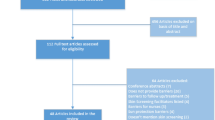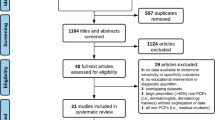Abstract
BACKGROUND: Primary care physicians (PCPs) are often expected to screen for melanomas and refer patients with suspicious pigmented lesions to dermatologists.
OBJECTIVE: To assess whether there is a difference between dermatologists and PCPs in accurately diagnosing melanoma and appropriately managing (based on decisions to refer/biopsy) suspicious pigmented lesions.
DESIGN, PARTICIPANTS: A survey based on a random sample of 30 photographs of pigmented lesions with known pathology was administered to 101 dermatologists and 115 PCPs from October 2001 to January 2003.
MEASUREMENTS: Likelihoods that a photographed lesion was melanoma and that the lesion should be biopsied/referred were scored on a 1 to 10 scale. Accuracy of melanoma diagnosis and appropriateness of pigmented lesion management were compared between dermatologists and PCPs by using the areas under (AUC) the receiver operating characteristic (ROC) curves.
RESULTS: Dermatologists were superior to PCPs in diagnosing melanomas (AUC 0.89 vs 0.80, P<.001) and appropriately managing pigmented lesions (AUC .84 vs 0.76, P<.001). PCPs who tended to biopsy lesions themselves did better at managing pigmented lesions than PCPs who did not perform biopsies. Dermatology training during residency did not significantly improve the diagnostic accuracy of PCPs nor their management of pigmented lesions.
CONCLUSIONS: Dermatologists have both better diagnostic accuracy and ability to manage pigmented lesions than PCPs. Yet, there is a shortage of dermatologists to meet the demand of accurate melanoma screening. More innovative strategies are needed to better train PCPs and enhance skin cancer screening.
Similar content being viewed by others
References
American Cancer Society. Cancer statistics 2005: A presentation from the American Cancer Society [presentation on the Internet]. Vol. 2005 [cited 2005 Sept 21]. Available at: http://www.cancer.org/docroot/PRO/content/PRO_1_1_cancer_statistics_2005_presentation.asp.
Jemal A, Clegg LX, Ward E, et al. Annual report to the nation on the status of cancer, 1975–2001, with a special feature regarding survival. Cancer. 2004;101:3–27.
Ries LAG, Eisner MP, Kosary CL, et al. (National Cancer Institute). SEER cancer statistics review, 1975–2002. Available at: http://seer.cancer.gov/csr/1975–2002/.
Jemal A, Murray T, Ward E, et al. Cancer statistics, 2005. CA Cancer J Clin. 2005;55:10–30.
Balch CM, Buzaid AC, Soong SJ, Atkins MB, Cascinelli N, Coit DG. Final verson of the American Joint Committee on Cancer staging system for cutaneous melanoma. J Clin Oncol. 2001;19:3635–48.
Burton RC, Howe C, Adamson L, et al. General practitioner screening for melanoma: sensitivity, specificity, and effect of training. J Med Screen. 1998;5:156–61.
Cassileth BR, Clark WH Jr., Lusk EJ, Frederick BE, Thompson CJ, Walsh WP. How well do physicians recognize melanoma and other problem lesions? J Am Acad Dermatol. 1986;14:555–60.
Dolan NC, Martin GJ, Robinson JK, Rademaker AW. Skin cancer control practices among physicians in a university general medicine practice. J Gen Intern Med. 1995;10:515–9.
Federman D, Hogan D, Taylor JR, Caralis P, Kirsner RS. A comparison of diagnosis, evaluation, and treatment of patients with dermatologic disorders. J Am Acad Dermatol. 1995;32:726–9.
Gerbert B, Maurer T, Berger T, et al. Primary care physicians as gatekeepers in managed care: primary care physicians’ and dermatologists’ skills at secondary prevention of skin cancer. Arch Dermatol. 1996;132:1030–8.
McGee R, Elwood M, Adam H, Sneyd MJ, Williams S, Tilyard M. The recognition and management of melanoma and other skin lesions by general practitioners in New Zealand. NZ Med J. 1994;107:287–90.
Paine SL, Cockburn J, Noy SM, Marks R. Early detection of skin cancer: knowledge, preceptions, and practices of general practitioners in Victoria. Med J Aust. 1994;161:188–9; 192–5.
Ramsay DL, Fox AB. The ability of primary care physicians to recognize the common dermatoses. Arch Dermatol. 1981;117:620–2.
Solomon BA, Collins R, Silverberg NB, Glass AT. Quality of care: issue or oversight in health care reform? J Am Acad Dermatol. 1996;34:601–7.
Whitaker-Worth DL. Clinical dermatologic education and the diagnostic acumen of medical students and primary care residents. Int J Dermatol. 1998;37:855–9.
Chen SC, Bravata DM, Weil E, Olkin I. A comparison of dermatologists’ and primary care physicians’ accuracy in diagnosing melanoma: a systematic review. Arch Dermatol. 2001;137:1627–34.
Bamber B. The area above the ordinal dominance graph and the area below the receiver operating characteristic graph. J Math Psychol. 1975;12:387–415.
Dorfman DD, Berbaum KS, Metz CE. Receiver operating characteristic analysis: generalization to the population of readers and patients with the jackknife method. Invest Radiol. 1992;27:723–31.
Insightful, Inc. S-Plus [computer program]. Version 6.1. Seattle, WA: Insightful, Inc; 2000.
Resneck JJ Jr., Kimball AB. The dermatology workforce shortage. J Am Acad Dermatol. 2004;50:50–4.
Oliveria SA, Christos PJ, Marghoob AA, Halpern AC. Skin cancer screening and prevention in the primary care setting: national ambulatory medical care survey 1997. J Gen Intern Med. 2001;16:297–301.
Geller AC, Koh HK, Miller DR, Clapp RW, Mercer MB, Lew RA. Use of health services before the diagnosis of melanoma: implications for early detection and screening. J Gen Intern Med. 1992;7:253–4.
Harris Jr JM, Salasche SJ, Harris RB. Can internet-based continuing medical education improve physicians’ skin cancer knowledge and skills? J Gen Intern Med. 2001;16:50–6.
Marks R. Two decades of the public health approach to skin cancer control in Australia: why, how and where are we now? Aust J Dermatol. 1999;40:1–5.
Marks R. Campaigning for melanoma prevention: a model for a health education program. J Eur Acad Dermatol Venereol. 2004;18:44–7.
Tsao H, Niendorf K. Genetic testing in hereditary melanoma. J Am Acad Dermatol. 2004;51:803–8.
Hansen C, Wadge L, Lowstuter K, Boucher K, Leachman S. Clinical germline genetic testing for melanoma. Lancet Oncol. 2004;5:314–9.
Author information
Authors and Affiliations
Corresponding author
Additional information
None of the authors have any conflicts of interest to declare.
Funding/Support: Dr. Chen is supported in part by a Mentored Patient Oriented Career Development Award (#K23AR02185-01A1) from NIAMS, NIH. Dr. Ming is supported in part by a Dermatology Foundation Career Development Award.
Rights and permissions
About this article
Cite this article
Chen, S.C., Pennie, M.L., Kolm, P. et al. Diagnosing and managing cutaneous pigmented lesions: Primary care physicians versus dermatologists. J Gen Intern Med 21, 678–682 (2006). https://doi.org/10.1111/j.1525-1497.2006.00462.x
Received:
Revised:
Accepted:
Issue Date:
DOI: https://doi.org/10.1111/j.1525-1497.2006.00462.x




